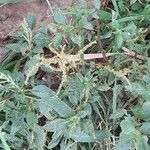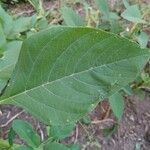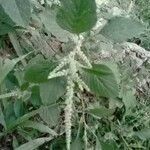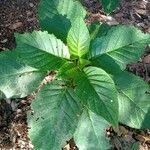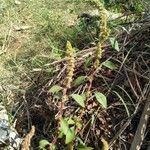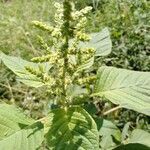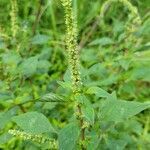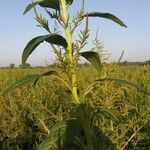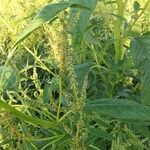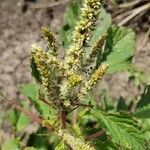Annual, erect, often much branched, 15-100 cm high; stem terete or obtusangular, green or more or less suffused with purple, glabrous or slightly pubescent. Leaves (largerones at least) rather long petioled, ovate-oblong-lanceolate, from acute, often slightly decurrent base, in their upper part gradually narrowed, obtuse, rounded or slightly retuse, often shortly mucronate, glabrous or, when young, slightly pubescent on the nerves; larger ones 3½-11 by 1¼-4½ cm. Flower-clusters dense; lower ones axillary; higher ones often collected in axillary and terminal spikes; spikes often branched in their lower part; terminal spike above base usually wholly ♂, with weak spines or quite unarmed, finally often with a drooping apex; axillary clusters and those on the base of the spike (rarely also the higher ones) usually armed with 2, or sometimes more, obliquely erect or patent, straight, thin, very sharp, ½- long spines (metamorphosedbracts), sometimes with one spine only, rarely (var. inermis SCHINZ) unarmed; bracts and bracteoles mucron-ate from a broad base, shorter than the adult perianth or at best as long. Tepals 5, shortly mucron-ate, very convex, with transparent margins and green or purple median band, in ♂ ovate-oblong, 2-2½ mm long, in ♀ oblong-spathulate, at first 1¼-1½ mm, under the ripe fruit 1¾-2¾ mm long. Filaments about equalling perianth or slightly longer or shorter. Ovary oblong; styles mostly 3, sometimes 2, when adult recurved and 1¼-1½ mm long. Utricle oblong, with a 3-lobed apex, circum-sciss a little below the middle. Seed with a thin margin, shining black or brownish black, ± 1 mm diam. or slightly larger.
Plants glabrous or sparsely pubescent in the distal younger parts of stems and branches. Stems erect or sometimes ascending proximally, much-branched and bushy, rarely nearly simple, 0.3-1(-2) m; each node with paired, divergent spines (modified bracts) to 1.5(-2.5) cm. Leaves: petiole ± equaling or longer than blade; blade rhombic-ovate, ovate, or ovate-lanceolate, 3-10(-15) × 1.5-6 cm, base broadly cuneate, margins entire, plane or slightly undulate, apex acute or subobtuse to indistinctly emarginate, mucronulate. Inflorescences simple or compound terminal staminate spikes and axillary subglobose mostly pistillate clusters, erect or with reflexed or nodding tips, usually green to silvery green. Bracts of pistillate flowers lanceolate to ovate-lanceolate, shorter than tepals, apex attenuate. Pistillate flowers: tepals 5, obovate-lanceolate or spatulate-lanceolate, equal or subequal, 1.2-2 mm, apex mucronate or short-aristate; styles erect or spreading; stigmas 3. Staminate flowers: often terminal or in proximal glomerules; tepals 5, equal or subequal, 1.7-2.5 mm; stamens 5. Utricles ovoid to subglobose, 1.5-2.5 mm, membranaceous proximally, wrinkled and spongy or inflated distally, irregularly dehiscent or indehiscent. Seeds black, lenticular or subglobose-lenticular, 0.7-1 mm diam., smooth, shiny.
Annual, monoecious or polygamo-monoecious, robust, glabrous herb to 1.5(-2) m; stems slightly woody at base, striate, green, pink or red; rigid stipular spines to 2.5 cm long, axillary, paired, spreading to slightly recurved. Petiole to 6(-8) cm long, about as long as blade; blade ovate to elliptical or rhombic, to 11 x 5 cm, undulate. Inflorescence of axillary clusters, 5-15 mm wide, terminal linear spikes or panicles to ca. 14 cm long; bracts lanceolate to subulate, 1-5 mm long, shorter than or only very slightly exceeding perianth, sometimes subspinose. Flowers green, white or brown, hyaline, midvein green. Male flowers usually at or near apex of terminal portion of inflorescence; tepals 5, lanceolate or oblong, 2.1 x 1.0 mm, acute, apiculate (outer 2 tepals mucronulate); stamens 5, anthers linear, to 2.3 mm long, apiculate. Female flowers more numerous than male flowers; tepals 5, lanceolate, oblong to elliptical, 1.5-2.5 x 1 mm, apex acute to retuse, mucronulate; stigmas 2-3, usually spreading. Utricle irregularly dehiscent or circumscissile, ovoid-conical, smooth or somewhat puckered below; seed lenticular, 0.7-1.1 mm wide, black or (reddish-)brown, lustrous.
Rather coarse, mostly glabrous armed annuals to 2 m. high, usually with erect branches. Leaves glabrous or pubescent below, narrowly rhombic-ovate, apically rounded to acute, basally acute to cuneate, 1-12 cm. long, 0.5-5 cm. broad; petioles 0.5-8 cm. long, with 2 thorns in their axils. Inflorescences of terminal and axillary thyrses racemosely disposed, the lower axillary thyrses globose and up to 15 mm. broad. Flowers polygamo-monoecious or monoecious, the bracts and bracteoles rather variable, lanceolate to acicular, 1-5 mm. long, often resembling the thorns, some conspicuously longer than the flowers; sepals 5, lanceolate to oblong, 1-2.5 mm. long, the midribs dark-green, the margins scariose; stamens discrete, 1-2 mm. long; ovary ovoid; styles 3, conical; stigmata 3, fimbrillate. Fruit a slightly rugose compressed ovoid utricle, irregularly to regularly circum-scissile, 1.5-2.5 mm. long; seeds cochleate-orbiculate, reddish brown to black, minutely reticulate, 0.7-1.0 mm. broad.
Stem erect, green or somewhat tinged purple, 30-100 cm tall, terete or obtusely angulate, much branched, glabrous or slightly pubescent. Petiole 1-8 cm, glabrous, 2-armed at base; leaf blade ovate-rhombic or ovate-lanceolate, 3-12 × 1-6 cm, glabrous or slightly pubescent along veins when young, base cuneate, margin entire, apex obtuse, with a mucro. Complex thyrsoid structures terminal or axillary, 8-25 cm; terminal spike usually with all male flowers at or toward apex. Bracts becoming very sharply spiny in proximal part of spike. Tepals green, transparent at margin and with green or purple median band, apex acute, with a mucro; male flowers oblong, 2-2.5 mm; female flowers oblong-spatulate, ca. 1.5 mm. Filaments nearly as long as or slightly shorter than perianth. Stigmas 3(or 2). Utricles included in perianth, oblong, 1-1.2 mm, circumscissile slightly below middle. Seeds brownish black, subglobose, ca. 1 mm in diam. Fl. and fr. Jul-Nov. 2n = 34, 68.
An annual plant 60-100 cm high. It can be erect or lie over. The stems can be nearly round or they can be angular. The plant branches from the base upwards. Leaves are fairly smooth or hairless but can be tinged purple. The leaf stalk can be 0.5-10 cm long. The leaf blade is oval or sword shaped and 2-7 cm long by 0.6-3 cm wide. There can be a short tip at the top end and gradually tapering to the base. Flower clusters occur at the sides and these can be single or arranged in compound spikes. The flower clusters at the top can be 3-10 cm long. The top flowers often droop over. Parts of the flowers in the clusters of the leaves form spines. These are very sharp. They can be 0.5-2 cm long. The upper flowers are male and the lower flowers are female. The seed are 1-1.2 mm across and flattened.
Glabrous erect, annual herb with stout, angular stems to c. 1 m high. Petioles slender, to c. 5 cm long. Lamina of infl.-lvs to c. 5 × 1.5 cm, ovate-lanceolate to oblong; veins prominently elevated below; base cuneate to attenuate; apex obtuse, usually with prominent mucro. Infl. to c. 10 cm long, green; terminal spikes slender; main branch much > lateral branches. Lower fl. clusters compact, all ♀, at least some with a pair of spines 6-12 mm long. Longer bracteoles 2.5-3 mm long, ovate with subulate tip and green keel; shorter bracteoles 2-2.5 mm long. Tepals 4-5, 1.5-2 mm long, oblong-obovate, green; keel narrow; apex acute or mucronate. Fr. ovoid-ellipsoid, circumscissile, not exceeding tepals. Seed 0.7-1 mm diam., orbicular, dark brown.
Monoecious; stem erect, branched, to 1 m, bearing at most nodes a pair of divergent spines 5–10 mm; lvs lance-ovate to ovate, 3–6 cm, narrowed to an obtuse, mucronate tip, broadly cuneate to the long petiole; spikes numerous, 5–15 cm, 6–10 mm thick, the terminal often chiefly or wholly staminate, the basal part and the axillary clusters mostly pistillate; sep of the pistillate fls 5, oblong, 1–1.5 mm; fr 1.5–2 mm, indehiscent or bursting irregularly, the terminal part spongy and roughened; seed suborbicular, 0.7–1 mm; 2n=32, 34. A pantropical weed, probably originally from the New World, extending n. in our range to N.Y., Pa., Ind., and Mo., seldom farther n.
Leaves glabrous, or thinly pilose on the lower surface of the primary venation, long-petiolate (petioles up to c. 9 cm. long, sometimes longer than the lamina), lamina lanceolate-ovate to rhomboid-ovate, elliptic, lanceolate-oblong or lanceolate, c. 1.5–12 × 0.8–6 cm., subacute or more commonly blunt or retuse at the apex with a distinct, fine colourless mucro, cuneate or attenuate at the base; each leaf-axil bearing a pair of fine and slender to stout and compressed spines up to c. 2.5 cm. long.
Annual herb, 0.3-1.5 m high, main stem erect with many branches, some glabrous or with short pubescence near inflorescence. Leaves ovate to lanceolate, glabrous or subglabrous, green without darker blotches, base attenuate, apex minutely mucronate; leaf axils with divaricate spines; petioles 30-70(-90) mm long. Inflorescences green, ± branched, terminal panicle. Flowers many axillary clusters, male and female separate. Flowering time Jan.? Seed very glossy, deep chestnut-brown.
Perianth segments 5, those of the female flowers c. 1.5–2.5 mm. long, narrowly oblong or spathulate-oblong, obtuse or acute, mucronulate, frequently with a greenish dorsal vitta; those of the male flowers broadly lanceolate or lanceolate-oblong, acute or acuminate, only the midrib green.
Flowers green, in the lower parts of the plant in axillary clusters 6–15 mm. in diam., towards the ends of the stem and branches the clusters leafless and approximated to form simple or (the terminal at least) branched spikes up to c. 15 cm. long and 1 cm. wide.
Bracts and bracteoles deltoid-ovate, pale-membranous, with an erect, commonly reddish awn formed by the excurrent green midrib: bracteoles shorter than to a little exceeding the perianth, commonly smaller than the bracts.
Capsule ovoid-urceolate with a short, inflated beak below the style-base, c. 1.5 mm. long, regularly or irregularly circumcissile or more rarely indehiscent, the lid rugulose below the beak.
Stem stout, sometimes reddish, usually branched, angular, glabrous or increasingly furnished above (especially in the inflorescence) with short or longer, multicellular, flocculent hairs.
Erect herb, up to 1.5 m high. Axils of stem leaves usually with paired spines. Inflorescences axillary or forming terminal branched or spike-like panicles. Flowers green.
Lower flower clusters entirely female, as are the lower flowers of the spikes; upper flowers of spikes male, mostly for the apical 1/4–2/3 of each spike.
Seed 0.75–1 mm. across, black, compressed, shining, very faintly reticulate.
Annual herb, erect or slightly decumbent, up to c. 1.5 m. in height.
Stigmas (2) 3, flexuose or reflexed, 1–1.5 mm. long.
Erect annual herb, 1–3 ft. high
A common weed.

